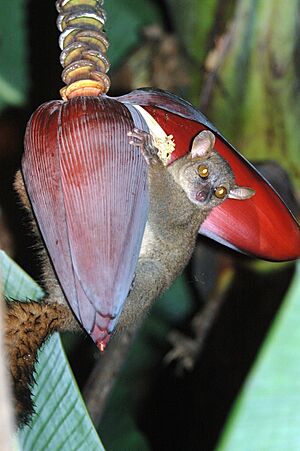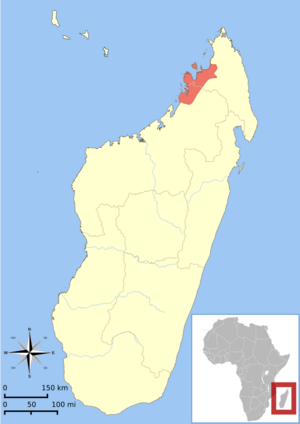Northern giant mouse lemur facts for kids
Quick facts for kids Northern giant mouse lemur |
|
|---|---|
 |
|
| Conservation status | |
| Scientific classification | |
 |
|
| Northern giant mouse lemur range |
The northern giant mouse lemur (Mirza zaza) is a small lemur found only on the island of Madagascar. It was discovered in 2005. These lemurs are part of a group called primates, just like monkeys and humans. They are known for being active at night (nocturnal).
They weigh about 300 grams (11 oz), which is roughly the weight of a can of soda. They have long, bushy tails and small ears. Unlike many lemurs, they often sleep together in groups, even with different males.
Contents
About the Northern Giant Mouse Lemur
What Does Its Name Mean?
The word zaza means "child" in the Malagasy language. This name was chosen for a few reasons. The northern giant mouse lemur is the smaller of the two giant mouse lemur species.
It also highlights the idea that today's Malagasy children have a special job. They are responsible for helping to protect Madagascar's amazing animals for the future.
How Big Are They?
The northern giant mouse lemur is quite small. Young lemurs, called juveniles, weigh about 150–199 g (5.3–7.0 oz). Teenagers, or subadults, weigh around 200–249 g (7.1–8.8 oz).
Fully grown adults weigh between 250–300 g (8.8–10.6 oz). This makes them one of the smaller lemur species.
Where Do They Live?
Northern giant mouse lemurs live in a very specific part of northwestern Madagascar. This area is called the Ampasindava peninsula. Two rivers, the Mahavavy River and the Maevarano River, divide their home. The Sambirano River also separates some areas.
This region has two main seasons. From May to October, it is dry and cool. From November to April, it is wet and hot. These lemurs live in a special area that connects to the evergreen rainforests.
They usually have a home range of about 0.52 to 2.34 hectares. This is like a small park. Different lemurs do not usually share the same exact home range. Scientists estimate there are about 385 to 1,086 lemurs per square kilometer in this area.
Daily Life and Reproduction
The northern giant mouse lemur is a nocturnal animal. This means it is most active at night. They mostly look for food during the second half of the night.
They usually stay about 7 metres (23 ft) high up in the trees. During the day, they sleep inside tree holes. These sleeping groups can have 2 to 8 lemurs. They include both males and females of all ages, even males who are not related.
These lemurs have a flexible mating system. They can reproduce at any time of the year, not just during a specific season.
Why Are They Vulnerable?
The northern giant mouse lemur is considered a vulnerable species by the IUCN. This means they are at risk of becoming endangered. The main reason for this is the loss of their habitat.
The forests where they live are being cut down. They are also being broken into smaller pieces and damaged. This makes it harder for the lemurs to find food and safe places to live. The species is also listed in CITES Appendix I. This means it is one of the most protected species in the world. International trade of these lemurs is not allowed.


